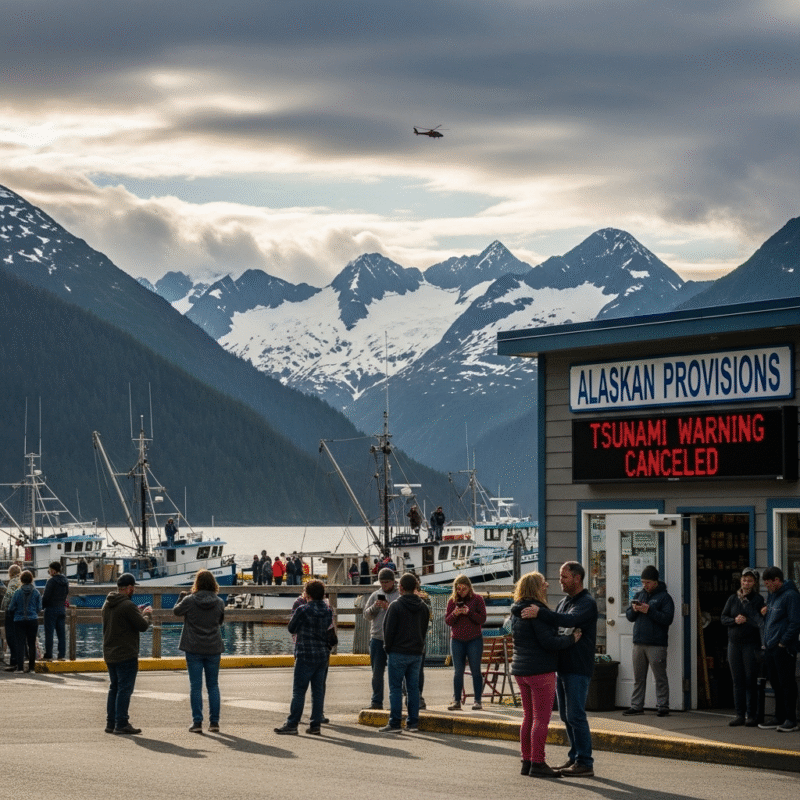Uncategorized
Respite for Coastal Alaska: Tsunami Warning Canceled After 7.3 Magnitude Quake
A powerful 7.3 magnitude earthquake that struck south of Sand Point, Alaska, on Wednesday prompted a tsunami warning for coastal regions, but fears of a destructive wave were allayed as the alert was later canceled.
The earthquake, which occurred at approximately 12:37 p.m. local time, was centered about 54 miles south of Sand Point, a community on Popof Island in the Aleutian chain.[1][2] The United States Geological Survey (USGS) reported the quake’s depth at around 12 miles.[3][4] The tremor was felt as far as 600 miles away in Anchorage.[2][5]
Initially, the National Tsunami Warning Center issued a tsunami warning for a 700-mile stretch of Alaska’s southern coast, from southwest of Homer to Unimak Pass.[6][7] This prompted evacuations in several communities, with residents moving to higher ground as a precautionary measure.[3] Videos shared on social media showed people in Seward heading to safer locations after receiving the alert.[3]
Fortunately, the warning was later downgraded to an advisory before being canceled altogether just before 2:45 p.m.[7] While a small tsunami was generated, with a recorded wave height of just a few inches at Sand Point, it did not pose a threat.[2][4] There have been no reports of significant damage or injuries from the earthquake or the minor tsunami.[8]
State Seismologist Michael West noted that earthquakes of this nature are common in this seismically active region, which is part of the Pacific “Ring of Fire”.[2] He also indicated that this event is likely part of a larger pattern of seismic activity along the subduction zone.[2] This was the fifth earthquake exceeding a magnitude of 7 in the same general area since 2020.[8]
Understanding Tsunami Alerts
This event serves as a critical reminder for coastal residents to understand the different levels of tsunami alerts:
-
Tsunami Watch: A tsunami is possible. Stay informed and be prepared to take action.[9]
-
Tsunami Advisory: A tsunami with the potential for dangerous currents or waves is expected or occurring. Stay out of the water and away from beaches and waterways.[9]
-
Tsunami Warning: A dangerous, widespread tsunami is imminent or expected. Evacuate immediately to higher ground.[4][9]
What to Do in a Tsunami Warning
Should you ever find yourself under a tsunami warning, immediate action is crucial. Here are some safety guidelines from preparedness experts:
-
Move to Higher Ground: As soon as you feel the ground shake, or receive an official warning, move to higher ground, at least 100 feet above sea level, or at least one mile inland.[5][9]
-
Follow Evacuation Routes: Be familiar with your community’s evacuation routes.[5]
-
If You’re at the Coast: If you are at the beach or in a harbor, get out of the water and move away from the coast immediately.[6]
-
Stay Informed: Listen to local radio or television for the latest updates and instructions from emergency officials.[10]
Essential Earthquake Preparedness
Living in a seismically active area like Alaska requires a constant state of readiness. Here are key earthquake safety tips:

-
Drop, Cover, and Hold On: During an earthquake, drop to the ground, take cover under a sturdy piece of furniture, and hold on until the shaking stops.[11][12]
-
If Outdoors: Move to an open area away from buildings, trees, and power lines.[12]
-
If Driving: Pull over to a clear location, away from overpasses and bridges, and stay in your vehicle.[7]
-
Have a Plan: Develop a family emergency plan, including a designated meeting place and an out-of-state contact.[5]
-
Prepare a Kit: Assemble an emergency kit with essentials like water, food, a first-aid kit, a flashlight, and a radio.[5]
While this recent event in Alaska ended without disaster, it highlights the ever-present natural forces shaping our planet and the critical importance of preparedness. By understanding the risks and knowing how to react, coastal communities can significantly enhance their safety and resilience in the face of future seismic events.


